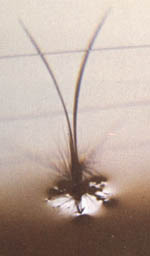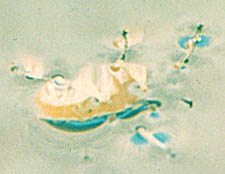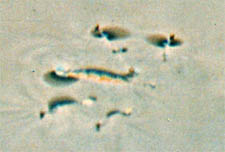|
Edges yellowed with age, tucked away under the book's
dust cover, the handwritten words ricocheted off the paper.
"... Perhaps you shall be able to convince the fly fishing world
of certain physical truths which I have failed to do in spite of all
my writing and talking."
Who was the writer? Very possibly the inventor of the first
dry fly! What was his mind set? After all, there were hundreds
maybe thousands of "dry" flies with names like Quill Gordon,
Cahill, and Beaverkill. Didn't those flies catch trout? You know
they did.
Confused? Let me back up here. It seems every fishing
magazine has yet another article on the originator of the dry
fly, not to mention the 'latest book' on the subject. Who is the
inventor this week? Scholarly appearing treatises have
appeared. And even more interpretations on those. Recently,
the fur and feathers have been flying again. Let's look at how
we got here, from way back in time. No name, rank or serial
number. Just how, not who.
Back in merry old England, people fly fished. No one
specifically claimed it was "dry fly" fishing. From everything I
can glean, it was wet fly fishing. The flies sank. It doesn't
appear there was any intent to make them float, not at first.
These tied bits were akin to what we would call nymphs. In
fact, they were sort of trolled. Not necessarily behind a boat,
although I have been some paintings where it appeared that
was the case indeed. History says they caught fish.
Poorly tied flies didn't always sink. Fishers had to wet them,
or use a little muck to weight them. Some flies almost floated.
They caught fish too.
Some observant individual, or group of individuals must
have been sitting beside the stream having their loaf of bread,
jug of wine, and thou. Perhaps they saw insects on the
surface of the water. Ah ha! Or maybe one flew into their
wine and didn't sink. No matter whether serendipity or genius
intervened, the floating fly came about. Other than the "dry
fly" all types of flies existed; it wasn't necessary to name
them, it was just fishing.
The idea that the trout would have to reveal himself on the
take took form. This is when just fishing took the giant leap to
sport ... fly-fishing became full-blown; the thrill of the rise was
discovered. And has been nurtured ever since.
Viewed floating in the surface film, hackles below the
surface resembled legs. A bulge in the body represented wing
cases. The floating fly certainly looked like an emerger.
Notice, the operative word here is floating. Not dry. Was
the technology available to make flies float? More or less. Even
with the paraffin treatment, the floating fly was just that
not a dry fly.
On the invisible time line, in the same era, someone figured
out how to make a line float. I suppose that's relevant. Hard
to have a sinking line (even if the leader floated) and a
floating fly. What were the leaders made from? Cat gut. Awful
stuff. Really high maintenance. But then, the fly lines were
high maintenance too.
All of the quoted important stuff about the development of
flies is from England or Europe. Interesting. What if nearly the
same thing was happening thousands of miles away?
Simultaneously? How about the South Pacific Islands?
Native peoples on far off Pacific islands also fished. Long
before sports fishermen flocked like snowbirds to warm
beaches, natives tied gobs of colorful feathers together to
catch fish. At some point they discovered you could oil the
feathers with coconut palm oil and they would float.
Where or when did the dry fly get into the equation? It
depends on how old you are. Or even if you are a reader.
Really. If you are a brash and untutored twenty-something,
you may think you invented the dry fly. We've all seen articles
in fly-tying and fly-fishing magazines where the writer thinks
he invented a particular fly. After all, he put his name on it. No
matter that someone else tied it before he was born.
Thirty-something? Gary LaFontaine. Forty-something?
Swisher & Richards. Fifty-something? Maybe Halford. Older
yet? A little gray creeping in at the temples? Bifocals too? Well
here we go, the nuts are off the buggy wheels.
Ever hear of Hewitt? LaBranch? Marinaro? Why would any
or all of them be the inventor of the dry fly? Because it had not
yet been invented. A 1940 book by William Bayard Sturgis,
Fly-Tying gives tying formulas for both "wet" and "dry" flies.
Some more recognizable patterns on both lists are: Beaverkill,
Cahill, Coachman, Ginger Quill, Gordon, Royal Coachman ...
you get the idea.

"The fly at the edge of the window, where the trout sees,
inspects and takes it is drab and dull, with no distinct color
rendition."
from "Rise of the Ring" by Vince Marinaro
Longer tails, and a little white for visibility were the major
differences. These variations, even if the instructions spoke
about tail length and hook-hackle balance, were simply a move
from fishing the fly totally submerged to floating on the
surface.
Looking sideways through an aquarium or jug of water
with a bug on the surface of the water is not reality. Nor is
photographing chilled or drugged bugs reality. The chilled or
drugged insect neither sits nor rides the water in a natural
way.
Reality lies in seeing the natural insect through the trouts
"window." That overhead hole in the mirrored surface of the
water the fish looks through. If the insect really rides the
water IN the surface film it indeed is a floating fly. Stone flies
are great examples of this.

"This is all the trout sees before the insect reaches
the edge of the window"
However, if what the trout sees are tiny dapples of
footprints denting the surface, no body, just "footprints" you
have a dry fly. Probably a mayfly at that. Why is this
important?

"What the trout sees is only footprints."
Photos Jim Birkholm
Back in the 1970's Dr. James Butler, while at Penn
State, did significant research on why trout feed. Part of his
conclusions is that trout instinctively key on certain
things. One of those things is footprints. Footprints? The tiny
dapples, meniscuses denting the surface of the water. Trout
see those footprints long before they see the insect. The
decision to take the insect (or fly) is made exactly by instinct.
Remember the old saw about fish biting in the rain?
Imagine what raindrops look like on the water from beneath
the surface Footprints? It could look like lunch for trout. Butler has trout keying on footprints. Marinaro has a fly
that makes footprints. Just like the insect. Marinaro took the
years of research and observation produced by
Hewett, as well as others, and added another twenty or more
years of his own research to it. The secret of the fly that
makes footprints is in the way the hackles are tied, and
placement of the body and wings.
Vince Marinaro was as comfortable on a stage as a
concert violinist as he was in the board room as a corporate
attorney. He was meticulous selecting either an onion for a
sauce or a section of bamboo for a rod. He wrote
passionately. And raised bugs. His presence did not leave the
room when he did.
On his only trip to Montana Spring Creeks he hired a guide.
The guide was shocked when Vince told him to bring a
shovel. Vince never cast a line to the creek full of trout. They
did dig up nymphs. The insects in various stages were
preserved in tiny bottles for future study.
"A Modern Dry-Fly Code," Vince's first book, was originally
published in 1950. In it are color photographs of the fly
patterns originated by Vince. The May Flies include the Green
Drake Dun and Spinner, Hendrickson Dun and Spinner, the
Sulphur Dun and Spinner and the Light and Dark Olive Dun.
The terrestrials, for which he is famous are also shown. Our
copy is dog-eared and marked.
The book was a great disappointment to him. Vince was the
writer of the letter quoted at the beginning of this story. What
was sadly missed by the majority of the flyfishing world (who
did understand the terrestrials) was the thorax tie.
Some writers have incorrectly described the fly, often
saying the crisscross hackles trap an air bubble and so it rides
high. Not so. True, the fly rides above the water. The hackles
do not puncture the surface film, but because of the angle at
which they are tied, the fly rides on the bent edges of the
hackle. Cutting a "V" in the underside of the hackle on a
traditionally tied fly does not work the same as tying the fly
per Vince's method.
Vince tried again with his second book,"In the Ring of the
Rise", published in 1976. This book contains excellent full color
photographs showing the rise forms, also illustrations and
photographs of what the trout sees. Sadly for Vince, the
terrestrials continued to maintain center stage.
Perhaps there is a reason the thorax tied fly has not
achieved the acceptance Vince expected. This truly gentle
man read, observed, and digested tremendous amounts of
knowledge. His conclusions were accurate. Thorax tied
mayflies absolutely work. The flies have the impact of an
earthquake. To a select few.
A few? Those fishers who have evolved to the point in their
fishing where they insist the trout take their fly exactly as it
would a natural insect. Not gonzo chuck and chance it. No
slash and grab. No flat refusal. A simple sipping take. One
after another. The elite of fly fishermen. Those who chose not
to fish nymphs even if they do catch fish. It is the principle of
the thing, you know. Those who have learned to tie a thorax
fly (and who have located hackle capable of tying it) probably
still believe upstream and dry is the only proper way to fly fish.
At least upstream and quartering.
Only recently, especially in England, Vince has become a
hero in fly-fishing circles. Thorax tied may flies may indeed yet
get their due, and Vince Marinaro credit for really inventing
the dry fly as well as the terrestrial.
Still not convinced? Buy, borrow or beg a copy of "A
Modern Dry-Fly Code." It has recently been reprinted. If you
live in the east or Midwest, tie a Hendrickson or two; Marinaro
style. Fish it.
Fishing the Spring Creeks in Montana? Forget the nymphs
and San Juan Worms. Have I got the wonder dry fly for you?
Chapter 10, page 258, Pale Sulphur Dun. Tie it "dry"! Vince
would thank you. And you'll thank Vince. ~ The LadyFisher
If you would like to comment on this or any other article please feel free to
post your views on the FAOL Bulletin Board!
|





